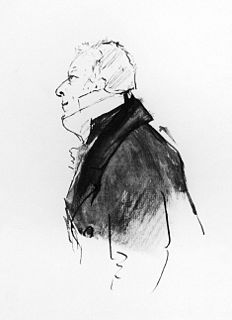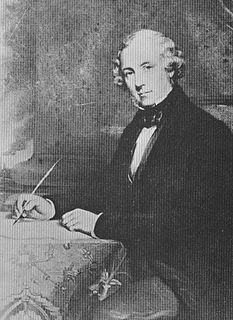Related Research Articles

Earl of Lichfield is a title that has been created three times, twice in the Peerage of England and once in the Peerage of the United Kingdom (1831). The third creation is extant and is held by a member of the Anson family.
The Peerage of the United Kingdom comprises most peerages created in the United Kingdom of Great Britain and Ireland after the Acts of Union in 1801, when it replaced the Peerage of Great Britain. New peers continued to be created in the Peerage of Ireland until 1898.

Earl of Coventry is a title that has been created twice in the Peerage of England. The first creation for the Villiers family was created in 1623 and took its name from the city of Coventry. It became extinct in 1687. A decade later, the second creation was for the Coventry family and is still extant.

John William Ponsonby, 4th Earl of Bessborough, PC, known as Viscount Duncannon from 1793 to 1844, was a British Whig politician. He was notably Home Secretary in 1834 and served as Lord Lieutenant of Ireland between 1846 and 1847, the first years of the Great Famine.

Earl of Bessborough is a title in the Peerage of Ireland. It was created in 1739 for Brabazon Ponsonby, 2nd Viscount Duncannon, who had previously represented Newtownards and County Kildare in the Irish House of Commons. In 1749 he was given the additional title of Baron Ponsonby of Sysonby, in the County of Leicester, in the Peerage of Great Britain, which entitled him to a seat in the British House of Lords. The titles Viscount Duncannon, of the fort of Duncannon in the County of Wexford, and Baron Bessborough, of Bessborough, Piltown, in the County of Kilkenny, had been created in the Peerage of Ireland in 1723 and 1721 respectively for Lord Bessborough's father William Ponsonby, who had earlier represented County Kilkenny in the Irish House of Commons.

Earl Jellicoe is a title in the Peerage of the United Kingdom. It was created, along with the subsidiary title Viscount Brocas, of Southampton in the County of Southampton, on 29 June 1925 for Admiral of the Fleet John Jellicoe, 1st Viscount Jellicoe, on his return from being Governor-General of New Zealand, with remainder to the heirs male of his body. He had already been created Viscount Jellicoe, of Scapa in the County of Orkney, on 15 January 1918, created with remainder to the heirs male of his body, and in default of such issue to his eldest daughter and the heirs male of her body, with the like remainder in default of such issue to every other daughter successively in order of priority of birth, and to the heirs male of their bodies. The Jellicoe viscountcy was created with remainder to his daughters and their heirs male because, at the time of the creation, Jellicoe had five daughters and no sons. His only son was born three months later.

Baron Monson (Munson), of Burton in the County of Lincoln, is a title in the Peerage of Great Britain. It was created in 18th century for Sir John Monson, 5th Baronet. The Monson family descends from Thomas Monson, of Carleton, Lincolnshire. He sat as Member of Parliament for Lincolnshire, Castle Rising and Cricklade. On 29 June 1611 he was created a Baronet, of Carleton in the County of Lincoln, in the Baronetage of England. His eldest son, the second Baronet, fought as a Royalist during the Civil War and also represented Lincoln in the House of Commons.
Baron de Mauley, of Canford in the County of Dorset, is a title in the Peerage of the United Kingdom. It was created on 10 July 1838 for the Whig politician the Hon. William Ponsonby, who had earlier represented Poole, Knaresborough and Dorset in the House of Commons. He was the third son of the 3rd Earl of Bessborough, an Anglo-Irish peer, and the husband of Lady Barbara Ashley-Cooper, one of the co-heirs to the ancient barony by writ of Mauley, which superseded the feudal barony the caput of which was at Mulgrave Castle, Yorkshire, which barony by writ had become extinct in 1415. His son, later the second Baron, sat as Member of Parliament for Poole and Dungarvon.

Earl Fitzwilliam was a title in both the Peerage of Ireland and the Peerage of Great Britain held by the head of the Fitzwilliam family.
Ponsonby may refer to:

Frederick Ponsonby, 3rd Earl of Bessborough, styled the Viscount Duncannon from 1758–1793, was an Anglo-Irish peer.
John George Brabazon Ponsonby, 5th Earl of Bessborough PC, styled Viscount Duncannon from 1844 until 1847, was a British cricketer, courtier and Liberal politician.

Baron Ponsonby, of Imokilly in County Cork, also referred to as Baron Ponsonby of Imokilly, in the County of Cork, was a title in the Peerage of the United Kingdom. It was created in 1806 for the William Ponsonby, who had previously represented Cork City, Bandonbridge and Kilkenny in the Irish House of Commons and Kilkenny in the British House of Commons. A member of the influential Ponsonby family, he was the eldest son of the Honourable John Ponsonby, second son of Brabazon Ponsonby, 1st Earl of Bessborough. His son, the second Baron, was a prominent diplomat and notably served as Ambassador to the Ottoman Empire and Austria. In 1839 he was created Viscount Ponsonby, of Imokilly in the County of Cork, in the Peerage of the United Kingdom. He was childless and the viscountcy became extinct on his death in 1855. He was succeeded in the barony by his nephew, the third Baron. He was the posthumous son of the Honourable Sir William Ponsonby, second son of the first Baron. Lord Ponsonby died childless and was succeeded by his first cousin, the fourth Baron. He was the son of the Right reverend the Honourable Richard Ponsonby, third son of the first Baron. He died unmarried in 1866 when the barony became extinct.

Lewis Watson, 1st Earl of Rockingham was an English peer and politician.

The Guest family is a British family that has been prominent in business and politics since the 18th century. It was involved in the British iron and steel industry, particularly the Dowlais Ironworks in Wales, which later became part of Guest, Keen and Nettlefolds. Hereditary titles held by members of the family include Baron Wimborne, Baron Ashby St Ledgers and Viscount Wimborne, all in the Peerage of the United Kingdom.
The Hon. George Ponsonby, was an Irish politician, who served as a Junior Lord of the Treasury in the governments under Earl Grey and Lord Melbourne from 1832 to 1834.

Lewis Watson, 1st Baron Rockingham was an English landowner and politician who sat in the House of Commons from 1621 to 1624. From 1621 to 1645 when he received his peerage he was known as Sir Lewis Watson, 1st Baronet. He supported the Royalist cause in the English Civil War and as a result was created Baron Rockingham. Watson was the son of Sir Edward Watson of Rockingham Castle and his wife, Anne Digby, daughter of Kenelm Digby of Stoke Dry, Rutland. He was baptised at Rockingham on 14 July 1584. He matriculated at Magdalen College, Oxford, on 24 May 1590. On 19 August 1608, he was knighted at Grafton. He succeeded to Rockingham Castle, which was leased from the crown, on the death of his father on 4 March 1616 and later acquired the fee of the castle and its lands from the crown.
Maria Ponsonby, Viscountess Duncannon, formerly Lady Maria Fane, was the wife of John Ponsonby, 4th Earl of Bessborough. She died before he inherited the earldom and thus was never Countess of Bessborough, but three of her sons were successively earls of Bessborough.
References
- ↑ "The Royal Buckhounds and their Masters". Baily's Magazine of Sports & Pastimes. Baily Brothers. 46: 95–103. 1 January 1886.
- ↑ "The Earl of Bessborough". Baily's Magazine of Sports & Pastimes. Baily bros.: 163 1 January 1863. Retrieved 8 December 2016.